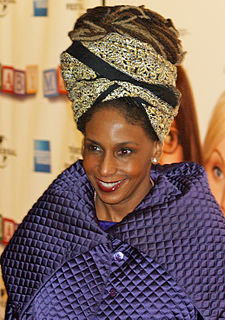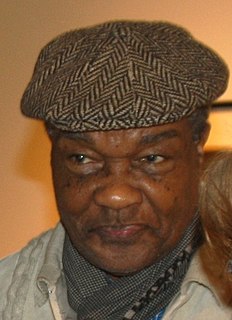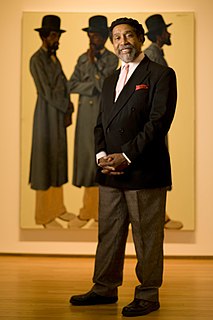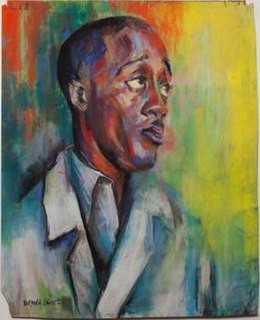Self-portrait as the black Jimmy Connors in the finals of the New Negro Escapist Social and Athletic Club Summer Tennis Tournament, 2008
Post-black art is a category of contemporary African American art. It is a paradoxical genre of art where race and racism are intertwined in a way that rejects their interaction. I.e., it is art about the black experience that attempts to dispel the notion that race matters. It uses enigmatic themes wherein black can substitute for white. [1] Some suggest the term is attributable to the 1995 book The End of Blackness by Debra Dickerson.
However, Thelma Golden claimed to have coined the term ‘post-black’ art with friend and artist Glenn Ligon in the late 1990s. [2] In 2001 the phrase was explained in detail in the exhibition catalogue for The Studio Museum in Harlem’s exhibition entitled "Freestyle." [1] Freestyle was an exhibition that included twenty-eight up and coming African American artists. Golden defined post-black art as that which includes artists who are “adamant about not being labeled ‘black’ artists, though their work was steeped, in fact deeply interested, in redefining complex notions of blackness.” [2] She continued, “They are both post-Basquiat and post-Biggie. They embrace the dichotomies of high and low, inside and outside, tradition and innovation, with a great ease and facility.” [3] Laura Meyers interprets this as “cutting edge works that are defined by not being defined as African American art.” [4] Golden stated her initial interest as an attempt to remove some of the negative associations with the phrase black art as well as comment on the diversity of artists of African descent. [5] In the exhibition catalogue, Golden proclaims, “Post-black was the new black.” [2]
As Golden explained, post-black art refers to a younger, post-Civil Rights generation of artists who are in search of a language through which they can explore their artistic interests and identities. Because artists of African descent have historically been marginalized and left outside of the general discourse on Western art history, there has not been one style or school of African American art. [6] The term ‘post-black’ attempts to encompass artists who have a variety of backgrounds and experiences, but all share experiences as a person of African descent.
While the notion of ‘post-black’ attempts to avoid identity labels, the title of ‘post-black’ serves as an ethnic marker. Some have found fault with this terminology, stating, “racism is real, and many artists who have endured its effects feel the museum is promoting a kind of art – trendy, postmodern, blandly international – that has turned the institution into a ‘boutique’ or ‘country club’, as David Hammons puts it.” [7] Golden has even stated that ‘post-black’ is “both a hollow social construction and a reality with an indispensable history.” [8]
Artists featured in The Studio Museum in Harlem’s Freestyle show included Kori Newkirk, Laylah Ali, Eric Wesley, Senam Okudzeto, David McKenzie, Susan Smith-Pinelo, Sanford Biggers, Louis Cameron, Deborah Grant, Rashid Johnson, Arnold Kemp, Julie Mehretu, Mark Bradford and Jennie C. Jones.

Renee Cox is a Jamaican-American artist, photographer, lecturer, political activist and curator. Her work is considered part of the feminist art movement in the United States. Among the best known of her provocative works are Queen Nanny of the Maroons, Raje and Yo Mama's Last Supper, which exemplify her Black Feminist politic. In addition, her work has provoked conversations at the intersections of cultural work, activism, gender, and African Studies. As a specialist in film and digital portraiture, Cox uses light, form, digital technology, and her own signature style to capture the identities and beauty within her subjects and herself.

The Studio Museum in Harlem is an American art museum devoted to the work of artists of African descent. The Museum’s galleries are currently closed in preparation for a building project that will replace the current building, located at 144 West 125th Street between Adam Clayton Powell Jr. Boulevard and Lenox Avenue in Harlem, Manhattan, New York City, with a new one on the same site. Founded in 1968, the museum collects, preserves and interprets art created by African Americans, members of the African diaspora, and artists from the African continent. Its scope includes exhibitions, artists-in-residence programs, educational and public programming, and a permanent collection.

David C. Driskell was an American artist, scholar and curator; recognized for his work in establishing African-American Art as a distinct field of study. In his lifetime, Driskell was cited as one of the world’s leading authorities on the subject of African-American Art. Driskell held the title of Distinguished University Professor of Art, Emeritus, at the University of Maryland, College Park.

Barkley L. Hendricks was a contemporary American painter who made pioneering contributions to black portraiture and conceptualism. While he worked in a variety of media and genres throughout his career, Hendricks' best known work took the form of life-sized painted oil portraits of Black Americans.

Norman Wilfred Lewis was an American painter, scholar, and teacher. Lewis, who was African-American and of Bermudian descent, was associated with abstract expressionism, and used representational strategies to focus on black urban life and his community's struggles.

Rashid Johnson is an American artist who produces conceptual post-black art. Johnson first received critical attention when examples of his work were included in the exhibition "Freestyle," curated by Thelma Golden at the Studio Museum in Harlem in 2001. He studied at Columbia College Chicago and the School of the Art Institute of Chicago and his work has been exhibited around the world.
Thelma Golden is the Director and Chief Curator of The Studio Museum in Harlem, New York City, United States. Golden joined the Museum as Deputy Director for Exhibitions and Programs in 2000 before succeeding Dr. Lowery Stokes Sims, the Museum's former Director and President, in 2005. She is noted as one of the originators of the term Post-Blackness.
Whitfield Lovell is a contemporary African-American artist who is known primarily for his drawings of African-American individuals from the first half of the 20th century. Lovell creates these drawings in pencil, oil stick, or charcoal on paper, wood, or directly on walls. In his most recent work, these drawings are paired with found objects that Lovell collects at flea markets and antique shops.
The term post-blackness is a philosophical movement with origins in the art world that attempts to reconcile the American understanding of race with the lived experiences of African Americans in the late 20th and early 21st centuries.
Arnold J. Kemp is an American artist who works in painting, print, sculpture, and poetry. Kemp received a BA/BFA from Tufts University and the School of the Museum of Fine Arts Boston, and an MFA from Stanford University.
Freestyle was a contemporary art exhibition at The Studio Museum in Harlem from April 28-June 24, 2001 curated by Thelma Golden with the support of curatorial assistant Christine Y. Kim. Golden curated the works of 28 emerging black artists for the exhibition, characterizing the work as ‘Post-Black’. The latter is a term she generated along with artist Glenn Ligon as a genre of art “that had ideological and chronological dimensions and repercussions. It was characterized by artists who were adamant about not being labeled as 'black' artists, though their work was steeped, in fact deeply interested, in redefining complex notions of blackness." Freestyle was her first major project at The Studio Museum in Harlem and the first of four ‘F’ themed series of exhibitions including Frequency, Flow and Fore.

Jennie C. Jones is an African-American artist living and working in Brooklyn, New York. Her work has been described, by Ken Johnson, as evoking minimalism, and paying tribute to the cross-pollination of different genres of music, especially jazz. As an artist, she connects most of her work between art and sound. Such connections are made with multiple mediums, from paintings to sculptures and paper to audio collages. In 2012, Jones was the recipient of the Joyce Alexander Wien Prize, one of the biggest awards given to an individual artist in the United States. The prize honors one African-American artist who has proven their commitment to innovation and creativity, with an award of 50,000 dollars. In December 2015 a 10-year survey of Jones's work, titled Compilation, opened at the Contemporary Arts Museum in Houston, Texas.
Christine Y. Kim is an American curator of contemporary art. She is currently Curator of Contemporary Art at the Los Angeles County Museum of Art. Before her appointment at LACMA in 2009, she was Associate Curator at The Studio Museum in Harlem in New York. She is best known for her exhibitions of and publications on artists of color, diasporic and marginalized discourses, and 21st-century technology and artistic practices.
Susan Smith-Pinelo is an African-American artist noted for her work in video and performance. She lives and works in Washington, DC.
Nyame Brown is an artist from San Francisco, CA whose multimedia work explores the intermingling of African-American pop culture and the larger African Diaspora. He received his BFA from The School of the Arit Institute of Chicago and his MFA from Yale University School of Art in 1997. He is currently a faculty member at the Oakland School of the Arts and has previously held positions at St. Mary's College of California, Notre Dame University, Illinois State University, and The Art Institute of Chicago. He is the recipient of the Richard Driehaus Foundation Individual Artist Award and the Joan Mitchell Foundation grant (2003). He was the Joan Mitchell Center Artist-in-Residence in Spring 2016.
Senam Okudzeto is an American and British artist and educator who lives and works in Basel, London, Ghana and New York City.
The term post-soul was coined by Nelson George in a 1992 Village Voice feature article, "Buppies, B-boys, BAPS, and Bohos." The article contained a chronology of significant shifts in African-American culture since the 1970s, exemplified by Melvin Van Peebles, Muhammad Ali, Stevie Wonder, and James Brown. In 2005, George reworked his chronology in a book entitled Post Soul Nation: The Explosive, Contradictory, Triumphant, and Tragic 1980s as Experienced by African Americans . Unlike the wider scope of George's original Village Voice article, Post-Soul Nation focuses on the 1980s to describe a series of political, social, and cultural shifts which helped reshape the African-American experience in the United States after the civil-rights era.
Alvia J. Wardlaw is an American art scholar, one of the country's top experts on African-American art. She is Curator and Director of the University Museum at Texas Southern University, an institution central to the development of art by African Americans in Houston. She is a professor of Art History at Texas Southern University. She is a member of the Scholarly Advisory Council of the (new) National Museum of African American History and Culture. She co-founded the National Alliance of African and African American Art Support groups in 1998. Dr. Wardlaw was University of Texas at Austin's first African-American PhD in Art History.
The Frequency Exhibition was a contemporary exhibition at the Studio Museum in Harlem from November 9, 2005 - March 12, 2006. Curated by Thelma Golden and associate curator Christine Y. Kim, the exhibition featured the works of 35 emerging Black artists. Frequency, following the 2001 exhibition "Freestyle," is one of five "F" themed exhibitions alongside Flow, Fore, and Fictions. While curators Golden and Kim point out that Frequency was not "Freestyle II," the organization of artists under the umbrella of Black identity engages with "Post-Black" art similarly to the Freestyle exhibition.
Black Romantic: The Figurative Impulse in Contemporary African-American Art was an exhibition held at the Studio Museum in Harlem from 25 April, 2002 until 23 June, 2002. The show was curated by Thelma Golden, the museum's Chief Curator. Black Romantic was a survey of Contemporary African-American genre painting whose stated purpose, as described by the Director of The Studio Museum, Lowery Stokes Sims was to show "elements of desire, dreams, determination, and romance particular to the black experience present a viewpoint that is oppositional to modernist conceptualization of blackness flavoured by exogenous exoticism, stereotype, caricature, and even abstractionist manipulation".








